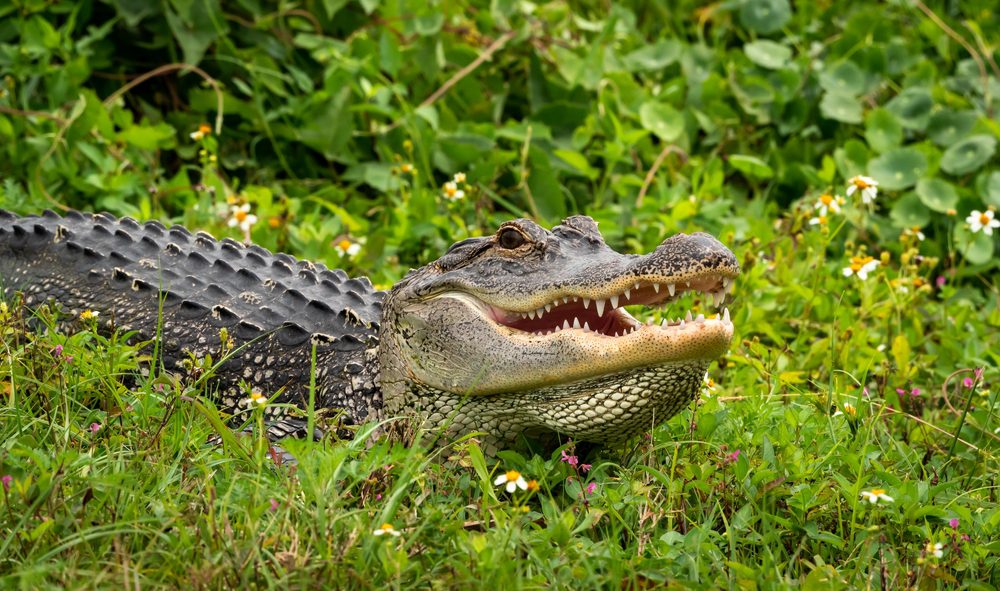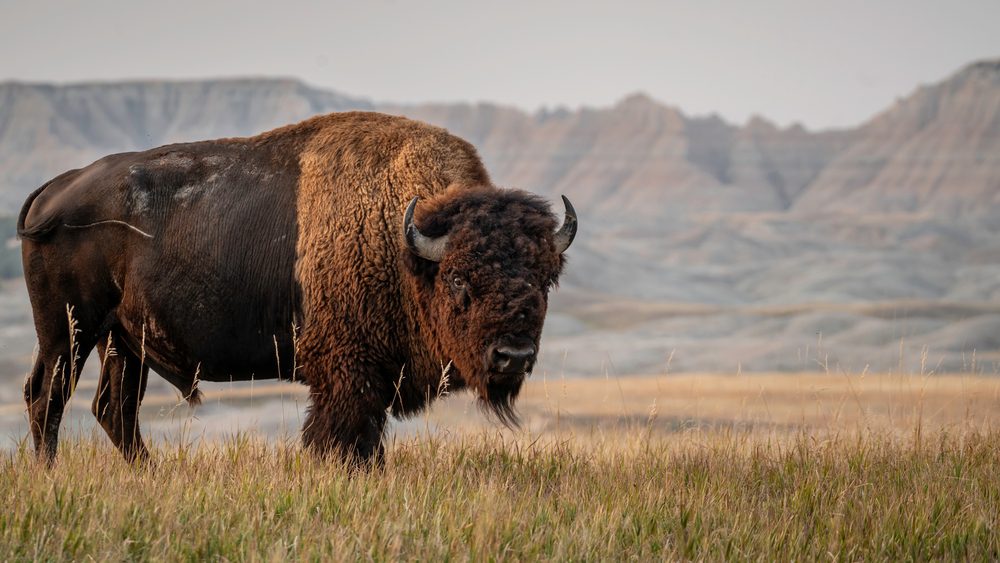Do you recognize all these North American animals?
The fauna of the United States of America refers to all the animals living in the Continental United States and its surrounding seas and islands. There is an estimated 432 species of mammals, 800 species of bird, 311 known reptiles, 295 amphibians, 1154 known fish species and more than 100,000 known species of insects currently calling the third largest of the world’s continents their home.
However, out of all those numerous species, there are only a few North American animals exclusive to this region and can only be found on the American supercontinent, with a lot of them protected in the more than 6770 national parks or protected areas peppered across the U.S.
So let’s have a look at ten of the most distinctive North American animals.

Bald Eagle
Let’s start with a North American animal every citizen knows as it adorns the Great Seal of the United States and can be found on the back of gold coins, the silver dollar, the half dollar and the quarter. This is of course the majestic bald eagle. Although strangely, despite the name, the bald eagle isn’t actually bald.
It was chosen to be a representative symbol of our country on June 20, 1782 but it had seen a few changes before it was finalized. The reason this North American animal was chosen was because it represents freedom. Living as he does on the tops of lofty mountains, amid the solitary grandeur of nature.
In the late 20th century it was on the brink of extirpation, when a species ceases to exist in a specific geographic location, though it still exists elsewhere in the contiguous United States. Their numbers have thankfully recovered and on July 12, 1995 it was removed from the list of endangered species and transferred to the threatened species list, a list it would also be removed from on June 28, 2007.
Hawaiian Monk Seal
The Hawaiian monk seal, part of earless seal in the family Phocidae, is sadly one of the most endangered marine species in the world and is one of two remaining monk seal species, the other being the Mediterranean monk seal. A third species, the Caribbean monk seal, is believed to be extinct as the last sighting of one was in 1952 at Serranilla Bank, between Jamaica and Nicaragua.
In desperate need of conservation, these beautiful North American animals are the only seal native to the equally beautiful Hawaii. Living mainly around the Northwestern Islands, there numbers currently stand at around 1400. They are currently on the International Union for Conservation of Nature’s ‘Red List’ of endangered species.
Although tiger sharks, great white sharks and Galapagos sharks are their main predators, their history with mankind has seen their numbers dwindle over the last century. In the nineteenth century, large numbers of seals were killed by whalers and sealers for meat, oil and skin, then U.S. military forces hunted them during World War II, while occupying Laysan Island and Midway.
Black Footed Ferret
Another occupant on the IUCN’s ‘Red List’ is the black-footed ferret, the only species of the ferret that is native to North America. It had actually been declared extinct in 1979 until a woman by the name of Lucille Hogg’s discovered a sadly dead one on her doorstep in Meeteetse, Wyoming, in 1981, her dog being the culprit.
After this discovery, it was established that only a few dozen remained in the wild until 1987, when they were officially considered by the IUCN to be an extinct in the wild species. Thankfully, in 1991, the United States Fish and Wildlife Service launched a captive breeding program.
Despite having over 1,000 mature, wild-born individuals and being reintroduced into eight western US states, Canada, and Mexico, this North American animal found itself back on the endangered species list in 2008.
Gila Monster
One of only two known species of venomous lizards in North America, the other being the Mexican beaded lizard, the Gila monster’s name and unwarranted fearsome reputation have seen their numbers suffer, so much so that in 1952, they became the first venomous animal to be given legal protection.
Despite being a ‘monster’, it’s slow moving and sluggish nature make it barely a threat to humans. Their size can of course be quite imposing and intimidating as they measure around 20 inches in length and up to 1.8 kg in weight. The lower jaws of the Gila monster consist of venom-producing glands and they pack quite a punch with their bite.
Many myths have sprung up about the Gila monster that are patently false. Some of which include that the animal’s breath is toxic enough to kill humans, that it can spit venom like a spitting cobra and that it can leap several feet in the air to attack. Rest assured, if for some reason you found yourself being bitten by one of these North American animals, it would certainly be painful but far from deadly.
American Black Bear
With the last three entries on this list being creatures that are in desperate need of conservation, it’s time to talk about a North American animal that is part of the IUCN’s least-concern species list, the American black bear, whose widespread and large population are believed to be twice that of all other bear species combined.
Similar to the bald eagle’s misnaming, not all black bears are actually black. There are actually sixteen American black bear subspecies, with some having brown or reddish-brown fur, there is actually one subspecies called a Cinnamon bear due to its fur being reminiscent of cinnamon.
These omnivores have had a long history with human beings, but unlike the fearsome legends associated with its grizzly, black bears feature prominently in the stories of some of America’s indigenous peoples. One tale telling of how the black bear was a creation of the Great Spirit, while the grizzly bear was created by the Evil Spirit.
Due to their large numbers, these North American animals do occasionally leave the protection of the forest and wander into human communities looking for easily available food but hardly ever attack and are rarely considered overly dangerous. The worst recorded fatality incident occurred in May 1978, in which an American black bear killed three teenagers who were fishing in Algonquin Park in Canada.

American Alligator
One of only two alligator species in the world, the other being the smaller Chinese alligator, the American alligator spends its time swimming through the freshwater rivers, swamps, and lakes of Southwestern United States and has the distinction of being the official state reptile of three states, Florida, Louisiana, and Mississippi.
Many find telling the difference between the American alligator and the American crocodile difficult, but this North American animal has shorter legs, a flat tail, a long broader snout, with overlapping jaws and darker coloration, preferring cooler climates than the tropical climates favored by the crocodile.
Like the previous entry, the black bear, this North American animal is also part of the IUCN’s least-concern species list. After being listed as an endangered species by the Endangered Species Act of 1973 due to hunting, a concerted effort was made to conserve this native reptile and bolster their numbers. This was so successful that just 14 years later in 1987 it was removed from its endangered status.
Luna Moth
The strikingly beautiful and large, it’s wingspan is an incredible 4.5 inches, Luna moth is a Nearctic moth in the family Saturniidae, subfamily Saturniinae, a group commonly known as giant silk moths. They inhabit the deciduous woodlands of United States, Southern Canada, and Northern Mexico.
This North American animal also has the distinction of being the first North American saturniid to be reported in insect literature. Described and named by the English apothecary James Petiver in 1700 as ‘Phalena plumata caudata’ which roughly translates to “brilliant, feather tail”.
The name was later changed in 1758 by Swedish botanist, zoologist, and physician Carl Linnaeus to Phalaena luna, then to Actias luna, with the Luna being derived from the Roman moon goddess and which is why it bares the name it has today.
Groundhog
Much like the movie Groundhog Day, the Swedish botanist, zoologist, and physician Carl Linnaeus returns again in this entry as he was the first to scientifically describe this North American animal, although he didn’t name it Punxsutawney Phil. The groundhog has garnered much popularity due to the yearly February 2 Groundhog Day celebrations.
Groundhog Day festivities take place in many locations all over North America and they all have their own named groundhogs, such as Wiarton Willie, Jimmy the Groundhog, Dunkirk Dave, and Staten Island Chuck to name a few. However, the groundhog itself goes by many names, a woodchuck, chuck, wood-shock, groundpig, whistlepig, whistler, thickwood badger, Canada marmot, monax, moonack, weenusk, red monk and, among French Canadians in eastern Canada, siffleux.
Although this North American animal belongs to the group of large ground squirrels known as marmots, most other species tend to live in rocky and mountainous areas but our little furry friend is quite content to live his life as a lowland creature.
Pronghorn
You could be forgiven for thinking that this North American animal is actually an antelope, many people colloquially refer to it as the American antelope, prong buck, pronghorn antelope, prairie antelope, or simply antelope, it is in fact the only surviving member of the family Antilocapridae, making it quite a unique animal of North America.
Pre-European settlement of North America saw large numbers of pronghorns hunted as a principal food source by America’s indigenous peoples. Although first described by Spanish explorers in the 16th century, this North American animal would not be formally recorded or scrutinized until an 1804–1806 expedition by Captain Meriwether Lewis and Second Lieutenant William Clark, with Clark being the first European to kill a pronghorn.
Their abundance on the North American continent continued to diminished over the following century, the wildlife conservation group Boone and Crockett Club at the turn of the 20th century even predicted that the pronghorn would likely become extinct. It wouldn’t be until December 31, 1936, that the true beginning for pronghorn recovery in North America would happen, when president Franklin Roosevelt signed an executive order creating a 549,000-acre tract for them.

American Bison
This magnificent North American animal is more of a symbol of old America as only around 500,000 bisons live across North America today, where as before the European colonization of the continent, there was an estimated 60 million bison roaming the river valleys, prairies and plains.
In 2016, the American bison became the national mammal of the United States but it had long been revered for many centuries by the Native American tribes, especially the Plains Indians, who considered a sacred animal and religious symbol.
Due to a combination of over hunting, slaughter and bovine diseases contracted from domestic cattle, by 1884 it was believed that this North American animal’s numbers had shrank to a minuscule 325, including 24 in Yellowstone. Due to conservation efforts, by 1910 the bison population had increase to 1,000 and with the continuation of those efforts, they are now half a million strong with 5,000 of them roaming Yellowstone Park.
We hope you found this article informative. If you find North American animals as cute as we do, we think you’ll really get a kick out of THIS!
And for another great read on magnificent creatures, we also recommend you check out: 8 Strange Uses of Animals in Warfare











